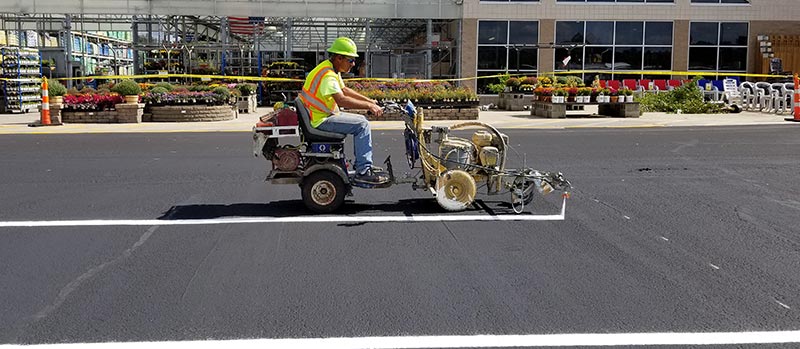5 Easy Facts About A1 Professional Asphalt & Sealing Llc Explained
Table of Contents4 Simple Techniques For A1 Professional Asphalt & Sealing LlcSome Known Factual Statements About A1 Professional Asphalt & Sealing Llc The smart Trick of A1 Professional Asphalt & Sealing Llc That Nobody is DiscussingSome Known Factual Statements About A1 Professional Asphalt & Sealing Llc Our A1 Professional Asphalt & Sealing Llc Statements

The oil in an auto engine is not just oil. It includes a variety of additives to boost the automobile's efficiency. These consist of polymers, viscosity modifiers, warm stabilizers, added lubricating substances, and use ingredients. The REOB includes all the ingredients that remained in the waste oil in addition to the wear steels from the engine (generally iron and copper).
By making lots of blends making use of different REOB samples and various asphalt binders, the variants mostly can be averaged out. Several States provided examples of known REOB make-up to TFHRC researchers, that evaluated the samples to contrast the percentage of added (understood) REOB to the found (checked) quantity. The analyses showed a comparable percentage of added and discovered REOB.
A1 Professional Asphalt & Sealing Llc Fundamentals Explained
None of those States understood that the asphalt they were purchasing had REOB. One State insisted its samples had no REOB - https://www.tumblr.com/a1asphaltseal/748214668409044992/the-a1-professional-asphalt-sealing-llc-family?source=share.
Of the 1,532 samples evaluated, 12 percent consisted of REOB, and some included substantially high degrees of it at 1020 percent. The highest degree was 34 percent in a sample from Texas, which TxDOT had actually utilized in a patching substance. This testing likewise exposed the existence of phosphoric acid in 11 percent of the samples, and 2 percent had ground tire rubber.
Two years ago at TRB's yearly meeting, the Federal scientists held an REOB workshop and provided the findings of their lab evaluations to a standing room-only group. Some firms do not especially outlaw REOB, they do enforce physical examinations that avert its useeffectively a ban. Others do not outlaw it by requirements, yet have arrangements with asphalt suppliers to prevent using REOB
All About A1 Professional Asphalt & Sealing Llc
Ohio and Texas limit degrees to much less than 5 percent of the asphalt. To develop a reputable test method that all States can use, the TFHRC researchers established up a round-robin examination plan.
In overall, the scientists prepared and shipped 720 blends. The participants are evaluating the samples individually using the standards supplied by the TFHRC scientists. The round-robin testing is almost finished, and TFHRC remains in the procedure of gathering the results. The result will be a proposed AASHTO examination technique that any type of State can adopt and make use of (a-1 asphalt).
The sidewalk with REOB, which is located 0.6 mile (1 kilometer) from the pavement without REOB, has identical subgrade, website traffic density, and climate. The section of Highway655 with 5 to 10 percent REOB showed considerable breaking. In this instance, the presence of REOB was the identified cause of splitting at a low temperatures.
An area of examination pavement in Minnesota (MN1-4) found to have REOB additionally split prematurely. The pavement executed well for the first 3 to 4 years, however after that started to split.
A Biased View of A1 Professional Asphalt & Sealing Llc
The examinations were not extensive, however they revealed that at levels of 6 percent or more, the tensile strength of the asphalt dropped dramatically. At a degree of 3.5 percent REOB, the variation in the physical examination methods was greater than the impact of REOB. As a matter of fact, it was challenging for researchers to examine whether REOB was present.

One binder specification considered is the distinction between the reduced temperature important requirements temperature level for tightness (S) in the flexing light beam rheometer and the flexing light beam rheometer creep slope (m-value) noted as Tcritical. 2 independent study groups, one from AASHTO and the various other from the Asphalt Institute, wrapped up that more study is needed on the use of REOB in asphalt.
Formerly, all asphalt testing gauged design homes such as tightness. These tests do disappoint what products had been included in the asphalt. One sample obtained during the TFHRC research study had a very unusual analysis. The sample had the following test outcomes: Superpave PG 64-28 with a heat quality of 67.3 Tcritical on the flexing light beam rheometer was 6.7 levels Celsius.

A1 Professional Asphalt & Sealing Llc Fundamentals Explained
These outcomes show click site there are weak points in the standard design screening procedures that may be exploited. The manufacturer might have an economic benefit and the item passes all the standardized tests, however the item might not be beneficial to ensuring long-lasting efficiency. To address this concern and the expansion of new asphalt ingredients and extenders, TFHRC is starting a study program to use handheld spectroscopic devices, x-ray fluorescence spectroscopy, and Fourier transform infrared spectroscopy to enable evaluations to be carried out in the field instead of needing to take samples back to the laboratory.